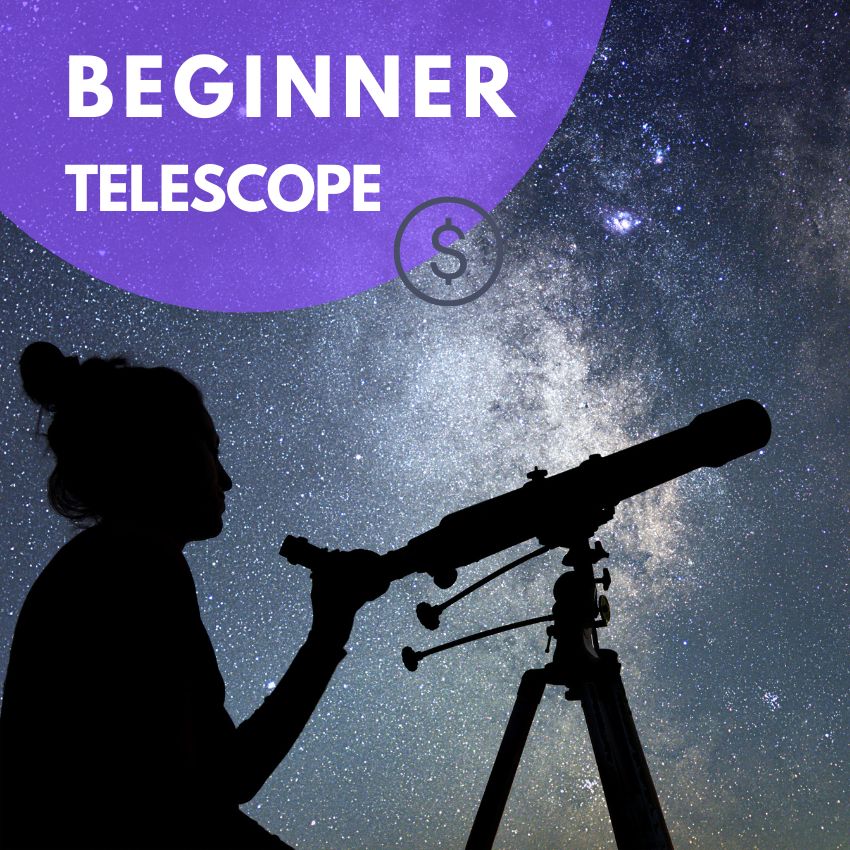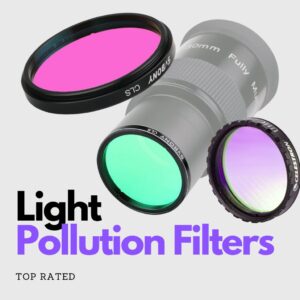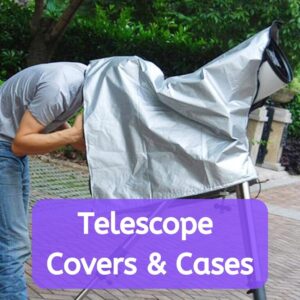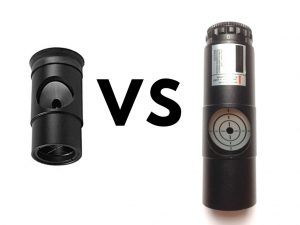This site contains affiliate links to products. I may receive a commission for purchases made through these links.
The ideal budget for a beginner telescope can vary depending on your interests, goals, and budget constraints. However, as a general guideline, it’s advisable to allocate between $100 to $300 for your first telescope. This budget range typically offers a selection of telescopes that are suitable for novice astronomers.
The key to finding the right telescope for you is determining your budget and the features you need. You want to make sure you get the most out of your money so you can enjoy amazing views of the stars and planets in our universe.
Your first telescope should have some basic features, such as the ability to adjust for various viewing angles, an easy-to-use control panel, and a reliable tripod that won’t wobble when you try to look through it.
Additionally, some telescopes may have motorized tracking, an illuminated reticle eyepiece, and other advanced features that can enhance your viewing experience.
By familiarizing yourself with the different types of telescopes and factors to consider when buying one, you can easily find the telescope that fits your budget and needs.
In this guide, we’ll cover types of telescopes for beginners, factors to consider when buying one, and the cost of a beginner telescope.
What you can expect between $100 to $300 for your first telescope?
Here’s a breakdown of what you can expect within this price range:
$100 to $200: Entry-level telescopes
- Telescopes in this range are often simple, easy to set up, and provide decent views of the moon and brighter planets.
- They are suitable for basic stargazing and lunar observations.
- Expect smaller apertures (around 70mm to 90mm) and lower-quality accessories.
$200 to $300: Intermediate-level telescopes
- Telescopes in this category offer better optics and larger apertures (around 90mm to 114mm).
- They provide clearer views of the moon, planets, and some deep-sky objects like star clusters and brighter galaxies.
- Quality mounts and accessories may be included in this price range.
It’s important to keep in mind that while a beginner telescope within this budget range can provide an excellent starting point, there are more advanced telescopes available at higher price points. As you progress in your astronomy journey, you may choose to invest in more sophisticated equipment for enhanced observations of deep-sky objects and astrophotography.
Ultimately, the right budget for your beginner telescope should align with your interests and commitment to the hobby. Starting with an affordable telescope allows you to explore the night sky and gain experience before considering more substantial investments in the future.
What is the best telescope for beginners?
The best telescope for beginners will depend on what type of celestial viewing you want to do. Generally, a refractor or reflector telescope is the most suitable for beginners.
Here are the best types of telescopes for beginners:
Reflector telescope for beginners
A reflector telescope uses a mirror to collect and focus light. This telescope is great for viewing bright planets, galaxies, star clusters, nebulae, and other bright objects in the deep sky.
A reflector telescope requires maintenance because the mirrors get out of alignment, especially when the telescope is moved. The tubes are open and allow dust to enter, so regular cleaning is required.
Although reflector telescopes require much maintenance, they are often less expensive than most. Their mirrors are cheaper to make than lenses, so you can get a lot of power for a low price.
Below $200, the Orion Observer 114mm Equatorial Reflector Telescope is an ideal beginner reflector telescope.
Pros of reflector telescopes
- Low cost compared to other types of telescopes
- Easy to use
- Good for viewing planets, galaxies, and star clusters
Cons of reflector telescopes
- Requires regular maintenance
- Mirrors can get out of alignment with frequent movement.
Refractor telescope for beginners
A refractor telescope uses two or more lenses to gather and focus light on the eyepiece. This telescope is great for viewing brighter objects like the moon, planets, star clusters, and galaxies.
It is a good choice for beginners because it is easy to use and requires minimal maintenance. The lenses are usually sealed in the tube, so dust won’t enter, and the optics don’t need to be adjusted like a reflector telescope.
Refractor telescopes cost more than reflector telescopes, but they provide brighter images, and you don’t need to replace the lenses as often. When you pass the 4 or 5-inch aperture, refractor telescopes become expensive.
Check out the Gskyer Refractor Telescope, one of the best refractor telescopes.
Pros of refractor telescopes
- Requires minimal maintenance
- Provides brighter and sharper images than reflector telescopes
- Lenses don’t need to be replaced as often
Cons of refractor telescopes
- More expensive than reflector telescopes
- It can get bulky, especially with a large aperture.
Read our in-depth guide: Reflector vs Refractor Telescope: Which One Do You Need?
Dobsonian telescope for beginners
Dobsonian telescopes are budget-friendly and an excellent choice for beginners. They use the same design as a reflector telescope but are mounted on an easy-to-use swivel base.
Dobsonian telescopes have a design that makes it easy for beginners to find objects in the sky. Its larger aperture allows you to view deep-sky objects with greater detail.
The mount pans and tilts in both vertical and horizontal directions. This allows you to adjust the telescope for better viewing angles easily. You can assemble and disassemble a Dobsonian telescope in minutes.
The low cost and large aperture make the Dobsonian telescope an excellent choice for anyone’s first telescope. However, it has similar shortcomings to reflector telescopes, such as needing regular maintenance and alignment.
You can get the Celestron 76mm Classic FirstScope, a compact and portable tabletop Dobsonian telescope for beginners, at under $100.
Pros of the Dobsonian telescope
- Budget-friendly
- Easy to set up and use
- Large aperture, great for viewing deep sky objects
Cons of the Dobsonian telescope
- Requires regular maintenance and alignment
Go-To computerized telescope for beginners
A Go-To computerized telescope is a computerized telescope that automatically locates and tracks celestial objects. It uses a database to find the coordinates of stars, galaxies, and other deep-sky objects.
This telescope is excellent for beginners because it eliminates the need to find objects manually and adjust your telescope. All you need to do is select the object you want to view, and the telescope will automatically move and adjust itself.
A Go-To computerized telescope is more expensive than other types of telescopes. Most of them feature a built-in GPS and require a power source, such as batteries or a wall outlet.
You can connect some modern models to smartphones or computers for more control and data. They are also heavier, bulkier, and require more maintenance, such as occasional software updates.
You may also like: 6 Best Telescopes With Phone Adapters (Before Purchasing)
The Celestron StarSense Explorer DX 130AZ is a smartphone app-enabled telescope that works with the StarSense app to help you find stars, planets, and more. It is a popular go-to telescope for tech-savvy beginners.
Pros of the Go-To computerized telescope
- Automatically locates and tracks objects
- Ideal for beginners who can’t manually locate objects
Cons of the Go-To computerized telescope
- Expensive
- Requires power source and regular updates
- Heavy and bulky compared to other types of telescopes
Learn more here: Are GoTo Telescopes Worth It? (My Real Experience)
Catadioptric telescope for beginners
The catadioptric telescope combines lenses and mirrors that produce images with great detail. It comprises a spherical mirror at the back of the scope that folds the light path and a curved lens at the front.
This design gives it a long focal length but keeps the overall size small, making it an ideal choice for portability. The optics have been designed to reduce chromatic aberration and distortions, making it a great choice for observers who want a clear image.
The catadioptric telescope is excellent for lunar observations. However, it has high focal ratios, which limits its ability to capture wide-field views of star clusters and planetary nebulae.
It is easy to use and requires minimal maintenance, making it a great choice for beginners. However, catadioptric telescopes are more expensive than others due to their complex optical design.
The Celestron NexStar 127SLT Computerized Telescope – 127mm Aperture is among the few telescopes that combine reflection and refraction.
How much is a good telescope for beginners?
The best telescope for you will depend on your budget, what type of objects you plan to observe, and how much time you plan to spend on astronomy. A good telescope for a beginner can range between $200 – $600.
Entry-level refractor telescopes with a 50 to 80 mm aperture and reflector telescopes with a 70 to 115 mm aperture can cost as little as under $200.
These telescopes are good for basic observations such as the Moon, planets, and some of the brighter star clusters and nebulae.
Their features vary depending on their price. For example, more expensive models may have better optics and larger apertures, whereas cheaper models may be simpler to set up and easier to use but have inferior optics.
You can get an excellent entry-level Orion SkyScanner Dobsonian telescope if your budget ranges from $200 – $400. It will have a greater aperture, better optics, and easier setup than reflector or refractor telescopes.
For budgets between $400 to $600, you typically get a quality entry-level Celestron Go-To telescope with a computerized mount that automatically locates and tracks celestial objects. Most models are in the 90 mm to 130 mm range.
The Go-To computerized telescope is a great choice for beginners because it eliminates the need to find and adjust your telescope manually.
You can get the Maksutov-Cassegrain catadioptric Telescope for Kids and Beginners at an unbelievably low price. It combines lenses and mirrors that produce images with great detail. Catadioptric telescopes have a complex optical design but produce excellent images for planetary and lunar observations.
Factors to consider when buying a telescope
Telescopes come in various aperture sizes, optical designs, mount types, and other features. A beginner’s needs are different from an experienced astronomer, so it’s important to consider the following factors before deciding which telescope is best for you.
Aperture size
The aperture is the diameter of the telescope’s lens or mirror. A greater aperture allows you to observe more detail and fainter objects. However, bear in mind that larger apertures require bigger, heavier mounts.
You may also like: What Is a Good Aperture for a Telescope?
Magnification
The magnification of a telescope determines how much detail you can observe, depending on how much an object appears enlarged.
Remember that more magnification does not always equal better images. Most telescopes can only magnify up to about 200x, beyond which the image will become blurry.
Mount type
The mount is what supports the telescope and allows it to move. An altazimuth mount is a telescope that can be moved up and down (altitude) or left to right (azimuth).
On the other hand, you can move an equatorial mount around in a circle to track objects as they move across the sky.
Computerized telescope mounts are more expensive, but they make locating objects much easier.
Quality of optics
Optics refer to the glass lenses or mirrors used for light gathering and image quality. High optical quality will allow you to observe more detail from distant objects, such as the night sky.
Generally, refractor and catadioptric telescopes have better optics than reflector telescopes. Reflector scopes have a much larger aperture than the other types, so they can still produce great images.
Ease of use
Using a telescope can be complicated, so consider how easy a telescope is to set up and operate before making a purchase.
Go-To computerized telescopes are great for beginners because they eliminate the need to manually find and adjust your telescope.
Other telescopes may require more effort to set up, such as aligning the mount and setting the clock. They may also require more knowledge and skill to obtain the best images.
Additional accessories
Examples of accessories include additional eyepieces, filters, and camera adapters. They can improve your viewing experience by allowing you to observe more detail or take photos of objects.
For under $100, you can get the powerful Celestron Zoom Eyepiece for Telescope with a maximum 24 mm zoom.
Other accessories, such as star charts, can help you learn more about the night sky and its objects.
Brand reputation and warranty
Finally, look for a reputable company that offers quality products and good customer service.
A reliable brand will offer warranties on their products, giving you peace of mind if something goes wrong with your telescope.
What is the cost of a good telescope for kids?
Young astronomers can enjoy many of the same features as adult astronomers but at a lower price. $100 or less can get you a good starter telescope with an aperture of 2.4 to 3.1 inches and a focal length of 600-1000mm for your child to explore the night sky.
The cost of more advanced telescopes increases with the aperture size, optical design, and other features. Consider a more expensive model if your child is interested in amateur astronomy.
Like for adult astronomers, viewing with a telescope for kids requires the right combination of factors such as quality of optics, ease of use, size and weight, and many others.
The 80 mm aperture ABOTEC telescope with an Adjustable Tripod has gained popularity among parents for their kids due to its easy-to-use features and quality materials.
Read also: ABOTEC Telescopes: Navigating the Best Models for Stargazing
Here are factors to consider when choosing a telescope for your child:
Size and weight
Kids need smaller, lightweight telescopes that they can easily carry and use. Telescopes with an aperture of 2.4 to 3.1 inches are usually the best for children.
The weight depends on your kids’ strength and age, but most telescopes weighing less than 5 pounds should be manageable.
Durability and safety
Kids will be more clumsy and careless when using a telescope. Look for models that are made of durable materials and designed with safety features.
Telescopes with padded or rubberized eyepieces can provide extra protection from bumps and falls. You also want to make sure the telescope is safe for night viewing, with eyepieces that protect your child’s eyes.
Ease of use
Kids may not have the same patience or experience as adult astronomers. Look for telescopes that are easy to assemble and use, such as computerized mounts that don’t require manual alignment.
Quality of optics
Optical quality is important for night sky viewing, even with smaller telescopes. Quality optics will produce clear, sharp images and allow your child to explore the sky in detail.
Refractor and catadioptric telescopes usually have good optics for sky viewing, but you should also consider the focal length and aperture size. Telescopes with a larger aperture can produce brighter images, even with smaller objects.
Additional features
Additional features such as night vision, video recording, and digital zoom make sky viewing more exciting. They also give your child more options for exploring the night sky.
Some telescopes also come with night sky maps and other learning materials. These can help your child learn more about sky objects and discover new ones.
Brand reputation
There are brands with a reputation for high-quality telescopes for kids. They are usually reliable and offer a good selection of features.
The following telescope brands are popular among amateur astronomers:
Celestron
Celestron is one of the most respected brands in astronomy and offers kids a wide range of telescopes. It was founded in 1959 and has become a leader in optical engineering technology.
Currently, Celestron specializes in computerized telescopes and sells a variety of models for beginners and advanced astronomers.
The Celestron 114 LCM Computerised Telescope is a 20-pound telescope with a 114mm objective lens, and a computerized mount is one of the most popular models for children.
Its database allows it to locate over 4,000 objects in the sky, including galaxies, star clusters, and nebulae.
You can also consider the Celestron NexStar Evolution 8, which has a built-in Wi-Fi network for wireless connection.
Orion
Orion has been around since 1975 and is known for its quality telescopes and accessories. Its products range from beginners to advanced models and offer manual, and GOTO (Go-To) mounts.
One of the best Orion telescopes for kids is the Orion StarMax 90mm TableTop Maksutov-Cassegrain Telescope.
This tabletop model has a 25 mm telescope eyepiece and a 90mm star diagonal. It is lightweight, portable, and perfect for kids interested in amateur astronomy.
Warranty and customer support
Reliable brands will usually offer a warranty on their products. This can give you peace of mind in case something breaks or fails to work properly.
They also provide customer service and support if you have any questions or issues. This can help you get the most out of your telescope and ensure your child enjoys a safe and exciting experience.
You may also like: Best Telescopes For Kids To Spark an Interest in Astronomy
What factors affect the cost of a telescope?
The most important factors affecting telescope cost are size and capabilities. A telescope with larger apertures, longer focal lengths, equatorial mounts, and other advanced features will cost more than a basic telescope.
The following are factors affecting telescope cost:
Brand reputation
Quality telescopes from reputable brands like Celestron are usually more expensive than lesser-known manufacturers. They offer more features and better optics, making them worth the extra money.
A company’s reputation can also indicate customer service and warranty coverage. The best companies have a track record of standing behind their products.
Quality of optics
Optics are the heart of a telescope, and the quality will determine its performance. Better optics cost more, but they will produce brighter images with better contrast.
Optics also affect the telescope’s ability to resolve small objects. A telescope with good optics can reveal details that a cheaper telescope will not.
Mount type
The types of mounts available for telescopes are equatorial, altazimuth, and computerized. An equatorial mount is more expensive but offers greater precision in tracking objects.
Altazimuth mounts are less expensive but provide a more limited range of movement. Computerized mounts use motors and a computer to track objects in the night sky. They are the most expensive telescopes but offer greater convenience and accuracy when tracking objects.
Additional features
Telescopes with additional features such as night vision, video recording, digital zoom, and computerized alignment are more expensive. But they provide more enjoyment and convenience. They also give more ways to explore the night sky.
The focal length
A telescope’s focal length affects the magnification it provides. Longer focal lengths produce higher magnifications, making them more expensive. But they are worth the extra money for closer views of night sky objects.
Materials used in making the telescope
Telescopes are made of different materials, including plastic, aluminum, and carbon fiber.
Telescopes made of higher-quality materials are more expensive but are usually worth the investment. They are ideal for kids because they are more durable and better able to withstand the elements.
The shipping cost of the telescope
A telescope’s shipping cost depends on its size, weight, and the location it’s being shipped to. Shipping costs for international orders may be significantly higher than for domestic orders.
The aperture size
The aperture of a telescope is the diameter of its primary mirror or lens. Larger apertures offer brighter, sharper images, and they are more expensive.
But they are worth the extra money for astrophotography and detailed observations of sky objects.
Manufacturing location
Telescopes made in the United States or Europe may cost more than those made in China. The quality of Chinese telescopes has improved in recent years, but it is still important to research before buying.
Customization options
Some telescopes offer additional customization options, such as custom-made mounts or focal-length adaptors. These can add to the telescope’s cost but may be worth it if they offer additional features or convenience.
The accessories included
Telescopes come with accessories such as filters, eyepieces, and tripods. They differ in every package and can add significantly to the cost. They are usually worth it, as they improve the telescope’s performance and convenience.
Takeaway: You don’t have to break the bank to get a good telescope
Choosing the right telescope involves more than just price. Quality of optics, mount type, additional features, and accessories all factor into the cost. But there are still good telescopes available at reasonable prices.
Researching and comparing different models can help you select a telescope that meets your needs without breaking the bank. Look for a telescope that offers good optics, additional features, and accessories for an affordable price. That way, you can explore the night sky without breaking the bank.
The types of telescopes ideal for beginners are refractors and reflectors, which are easy to use.
With a higher budget, you can go for a Go-To telescope with a computerized mount. This type of telescope is easy to set up and use, and you can access thousands of deep sky objects with the push of a button.
Your kids can also join in the fun and make their observations with smaller telescopes. They can even take part in stargazing and skywatching activities with their friends.
Happy stargazing!
Read also:













